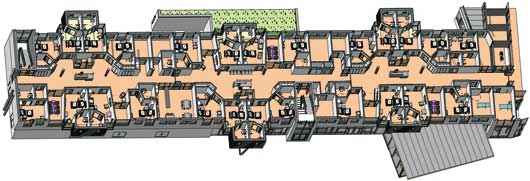Design affects patient care
The design of “bed clusters” is important.
This finding has emerged from a report from hospital researchers at SINTEF. The “bed cluster concept” means that patient rooms are grouped into a “courtyard”, with beds in seven to nine rooms, and the old nurses’ room has been replaced by three decentralized workstations.
Less walking time
Bed clusters are in widespread use in Norway’s newer hospitals, and internationally in countries like the USA, the UK, Sweden, Denmark and Latvia. The thinking behind this concept is that in the future there will be increasing number of ill patients, and that when nurses are closer to their patients, they can monitor them better.
“The configuration and the way the clusters are used are different. It is this effect we have been studying,” says hospital researcher Marte Lauvsnes at SINTEF Technology and Society.
“A hospital like St Olavs in Trondheim has configured the bed clusters in several different ways. One area has three clusters in series. Another is built in short wings that put two clusters next to each other, while a third is separate. The final configuration was dictated by building area constraints, and the solution is clearly not as good as when the clusters are arranged in series.”
No place to socialize
The nursing staff find that the new model means that they each work with fewer patients and cooperate less with their colleagues.
«During night shifts, there may only be one nurse on duty per cluster, but if the clusters are arranged like “pearls on a necklace”, this still allows nurses to to talk and work together», says Marte Lauvsnes.
The hospital researchers at SINTEF conclude that if a bed cluster model is chosen, it must be decided at an early stage in the building planning process.
Åse Dragland




